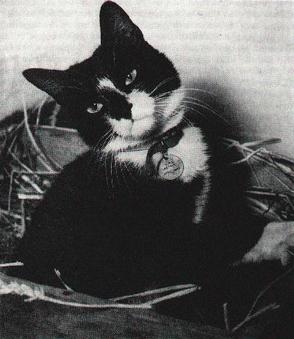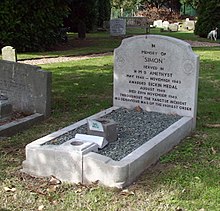
The PDSA Dickin Medal was instituted in 1943 in the United Kingdom by Maria Dickin to honour the work of animals in World War II. It is a bronze medallion, bearing the words "For Gallantry" and "We Also Serve" within a laurel wreath, carried on a ribbon of striped green, dark brown, and pale blue. It is awarded to animals that have displayed "conspicuous gallantry or devotion to duty while serving or associated with any branch of the Armed Forces or Civil Defence Units". The award is commonly referred to as "the animals' Victoria Cross".

The People's Dispensary for Sick Animals (PDSA) is a veterinary charity in the United Kingdom. It was founded in 1917 by Maria Dickin to provide care for sick and injured animals of the poor. It is the UK's leading veterinary charity, carrying out more than one million free veterinary consultations a year, and was until 2009 the largest private employer of fully qualified veterinary surgeons and veterinary nurses in the UK; only those living within the PDSA's catchment areas can use their services.

Simon was a ship's cat who served on the Royal Navy sloop-of-war HMS Amethyst. In 1949, during the Yangtze Incident, he received the PDSA's Dickin Medal after surviving injuries from an artillery shell, raising morale, and killing off a rat infestation during his service.

The PDSA Gold Medal is an animal bravery award that acknowledges the bravery and devotion to duty of animals. It was created by the People's Dispensary for Sick Animals (PDSA) in 2001, and is now recognised as the animal equivalent of the George Cross. The Gold Medal is considered as the civilian equivalent to PDSA's Dickin Medal for military animals. An animal can be awarded the PDSA Gold Medal if it assists in saving human or non-human life when its own life is in danger or through exceptional devotion to duty. The medal can also be awarded to animals in public service, such as police or rescue dogs, if the animal dies or suffers serious injury while carrying out its official duties in the face of armed and violent opposition.
Sadie,, a black Labrador Retriever, is a recipient of the Dickin Medal, the animal equivalent of the Victoria Cross. She was awarded for detecting an explosive device outside the United Nations headquarters in Kabul in November 2005, and was awarded by Princess Alexandra on 6 February 2007. Her handler at the time of the action which resulted in the award was Lance Corporal Karen Yardley.
Maria Elisabeth Dickin CBE was a social reformer and an animal welfare pioneer who founded the People's Dispensary for Sick Animals (PDSA) in 1917. The Dickin Medal is named for her.
Gander was a Newfoundland dog posthumously awarded the Dickin Medal, the "animals' Victoria Cross", in 2000 for his deeds in World War II, the first such award in over 50 years.

Jet of Iada a.k.a. Jet was a German Shepherd Dog, who assisted in the rescue of 150 people trapped under blitzed buildings. He was a pedigree dog born in Liverpool, and served with the Civil Defence Services of London. He was awarded both the Dickin Medal and the RSPCA's Medallion of Valor for his rescue efforts.
Crumstone Irma, a.k.a. Irma, was a German Shepherd Dog who assisted in the rescue of 191 people trapped under blitzed buildings while serving with London's Civil Defence Services during the Second World War. During this period she worked with her handler and owner, Mrs Margaret Griffin, and another dog named Psyche. Noted for her ability to tell if buried victims were dead or alive, she was awarded the Dickin Medal in 1945, and is buried at the PDSA Animal Cemetery, Ilford.

Rip, a mixed-breed terrier, was a Second World War search and rescue dog who was awarded the Dickin Medal for bravery in 1945. He was found in Poplar, London, in 1940 by an Air Raid warden, and became the service's first search and rescue dog. He is credited with saving the lives of over 100 people. He was the first of twelve Dickin Medal winners to be buried in the PDSA's cemetery in Ilford, Essex.
Buster, an English Springer Spaniel, was a military detection dog who was active during the Iraq War. Because of his actions in discovering a hidden weapons cache, the dog was credited with saving service personnel from insurgents operating in the southern Iraqi town of Safwan. He was awarded the Dickin Medal, referred to as being the animals' Victoria Cross.
Mary of Exeter was a carrier pigeon who flew many military missions with the National Pigeon Service during World War II, transporting important messages across the English Channel back to her loft in Exeter, England. She was awarded the Dickin Medal in November 1945 for showing endurance on war service despite being injured on three occasions and emerging uninjured when her loft was bombed.
Beauty, a wirehaired terrier, was a Second World War search and rescue dog considered to be the first rescue dog, who was awarded the Dickin Medal for bravery in 1945. She is among a number of Dickin Medal winners who are buried in Ilford Animal Cemetery.
Peter (1941–1952) was a collie dog who in 1945 was awarded the Dickin Medal, considered to be the Victoria Cross for animals. During the later stages of the Second World War he served as a search and rescue dog in London. He attended the 1946 Civil Defence Stand–Down parade, where he was presented to the King and Queen, and Princess Elizabeth. His medal was auctioned in 2000 for £4,600 (US$6,964).
Tich (1940–1959) was a military dog during the Second World War. She was awarded the Dickin Medal in 1949 for her actions during the war as a battalion mascot to the King's Royal Rifle Corps. After the war she lived with her battalion handler at his home in the UK. When she died she was buried in the People's Dispensary for Sick Animals (PDSA)'s Ilford Animal Cemetery.
Theo DM (2009–2011), was an English Springer Spaniel who served as a bomb detection dog for the British Army whilst stationed in Afghanistan. His handler, Lance Corporal Liam Tasker, was killed in March 2011, and Theo died within hours, following a seizure. The pair had set a new record for bomb finds during their time on deployment. Theo was awarded the Dickin Medal, also known as the animals' Victoria Cross, in 2012.
Ricky was a dog who received the Dickin Medal in 1947 from the People's Dispensary for Sick Animals for bravery in service during the Second World War.

Bing was a dog who received the Dickin Medal in 1947 from the People's Dispensary for Sick Animals for bravery in service during the Second World War.
The British pet massacre was an event in 1939 in the United Kingdom where over 750,000 pets were killed in preparation for food shortages during World War II.

Lucca was a German Shepherd/Belgian Malinois service dog who was employed by the United States Marine Corps for 6 years. She was trained to detect explosives. She was deployed twice to Iraq and once to Afghanistan. In her over 400 missions, no human fatalities occurred under her watch. In 2012, while on patrol in Afghanistan, she was injured by an IED blast, necessitating the amputation of her left leg. After recovering at Camp Pendleton, Lucca officially retired in 2012 and was adopted by her original handler, Gunnery Sergeant Chris Willingham.









